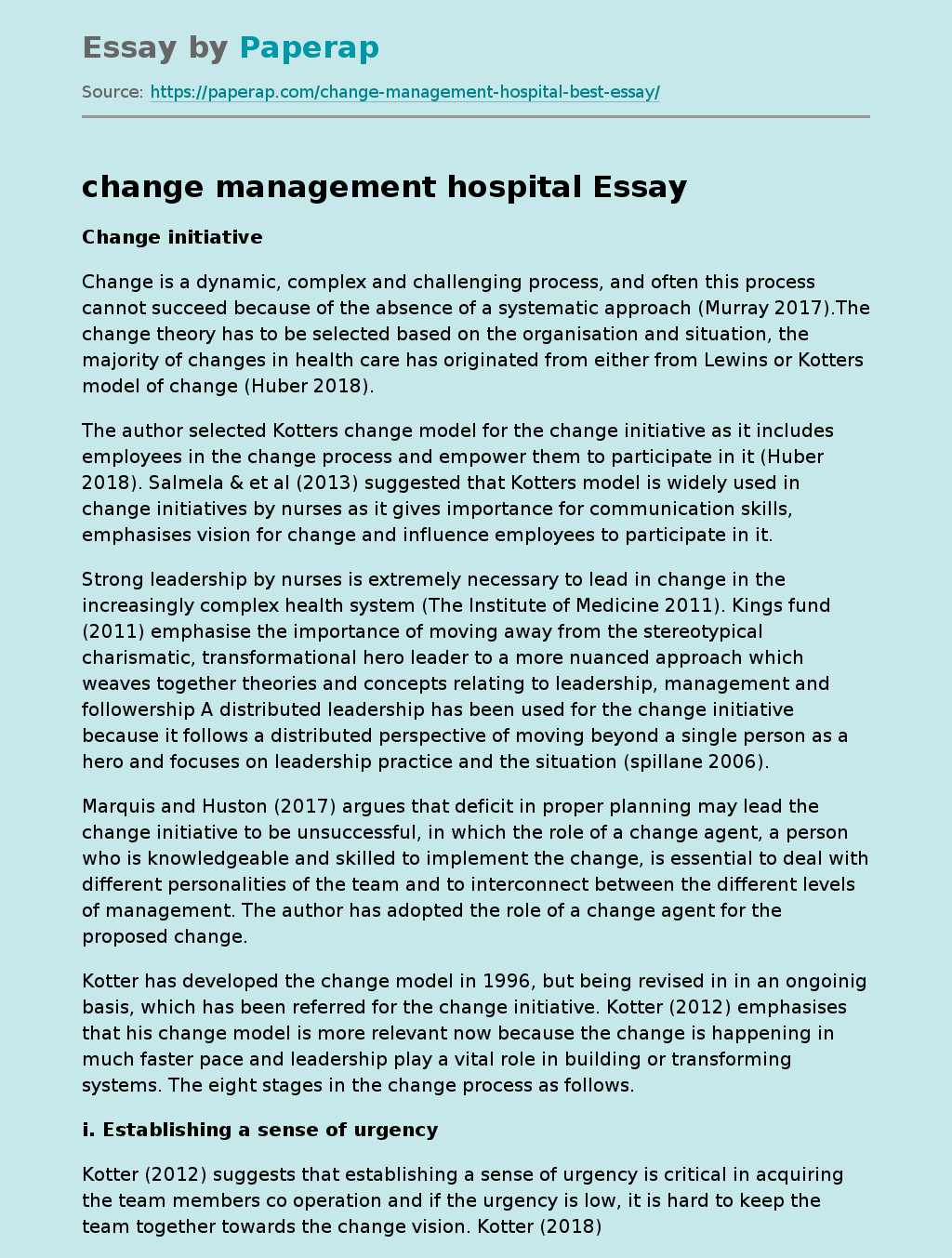change management hospital
Change initiative
Change is a dynamic, complex and challenging process, and often this process cannot succeed because of the absence of a systematic approach (Murray 2017).The change theory has to be selected based on the organisation and situation, the majority of changes in health care has originated from either from Lewins or Kotters model of change (Huber 2018).
The author selected Kotters change model for the change initiative as it includes employees in the change process and empower them to participate in it (Huber 2018).
Salmela & et al (2013) suggested that Kotters model is widely used in change initiatives by nurses as it gives importance for communication skills, emphasises vision for change and influence employees to participate in it.
Strong leadership by nurses is extremely necessary to lead in change in the increasingly complex health system (The Institute of Medicine 2011). Kings fund (2011) emphasise the importance of moving away from the stereotypical charismatic, transformational hero leader to a more nuanced approach which weaves together theories and concepts relating to leadership, management and followership A distributed leadership has been used for the change initiative because it follows a distributed perspective of moving beyond a single person as a hero and focuses on leadership practice and the situation (spillane 2006).
Marquis and Huston (2017) argues that deficit in proper planning may lead the change initiative to be unsuccessful, in which the role of a change agent, a person who is knowledgeable and skilled to implement the change, is essential to deal with different personalities of the team and to interconnect between the different levels of management.
The author has adopted the role of a change agent for the proposed change.
Kotter has developed the change model in 1996, but being revised in in an ongoinig basis, which has been referred for the change initiative. Kotter (2012) emphasises that his change model is more relevant now because the change is happening in much faster pace and leadership play a vital role in building or transforming systems. The eight stages in the change process as follows.
i. Establishing a sense of urgency
Kotter (2012) suggests that establishing a sense of urgency is critical in acquiring the team members co operation and if the urgency is low, it is hard to keep the team together towards the change vision. Kotter (2018) argues that there are many evidences for most of the transformations fail and the major reason behind it is to develop and sustain a sense of urgency for the change initiative.
The main resistances to develop the need for change among the team members are the presence of complacency among the team members or they sincerely think that it is inessential or wrongheaded (Kotter 2012). Hence it is the responsibility of the change agent or the nurse leader to discuss with the team regarding the benefits of the change initiative or the identified potential crises with evidences (Murray 2017). The change agent requires to gather data for the necessity and the benefits of the change initiative as a strong indication for implementing the change (Sullivan 2018).
For the initiation of the proposed change initiative, the change agent will be discussing with relevant stake holders regardind the importance and the benefits of introducing ISBAR handover tool to the patient, staff and to the organisation with evidence. Kirchner & et al (2012) conducted a study regarding stakeholders perspectives for improving quality implementation and concluded that eventhough the participation of different types of stake holders would be costly for the organisation, it is necessary for the achievement of the highest quality care. For effective implementation of change, key stakeholders and champions need to be identified (Curtis& Cullen 2017). All key stake holders will be included in the discussion such as the head of anaesthetists, assistant director for theatre department, theatre manager, representatives of NPDU, risk assessment committee, auditing committee, quality team, clinical nurse managers from theatre and the nursing staff team and their suggestions will be valued. The necessity and the impact of the handover tool will be discussed again in details with the PACU nurses, their suggestions will be valued and queries will be clarified based on evidences. The resistance among the team members will be identified and clarified by emphasising the importance of ISBAR tool in PACU.
ii. Creating the guiding coalition
Kotter (2012) highlights the importance of a team working towards a goal other than an important person trying to implement the change. More chances of change to be successful if there are more eyes to see, more brain to think and more hands to do (Kotter 2018). Trust, leadership and focussing towards a common goal are vital factors in building team work (Kotter 2012, Ramasamy & Ganesan 2017). Diversity of team members, respect, dignity and a commitment to change among the team members will lead to a successful change (Kotter 2018). Distibuted leadership play a vital role as it is a team work rather than an individual action (Bennett & et al 2003). Resistance But internal hierarchial power and management can be a hindrance for the success of this step and the team members may find in a difficult position between the clinical duties and leadership (Martin & et al 2015). Also lack of trust and underestimating abilities can reduce the morale the team members (Kotter 2012).
The change agent will be organising team discussions, will be identifying the key members as champions to lead in the change initiative and empowering them to actively participate in the change initiative.
change management hospital. (2019, Dec 06). Retrieved from https://paperap.com/change-management-hospital-best-essay/

